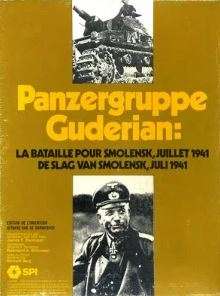Panzergruppe Guderian (game)
Panzergruppe Guderian is a board wargame published by Simulations Publications, Inc. in Strategy & Tactics magazine issue 57 in 1976.
Description

Panzergruppe Guderian was designed by James F. Dunnigan, and simulates the 1941 World War II Battle of Smolensk between the German Wehrmacht and the Soviet Red Army on an operational level. The game counters mostly represent German regiments and Soviet divisions. The hexagonal grid board map has a scale of 10.5 kilometers per hex; the game takes twelve turns, which represent two days.
A new edition of the game was reprinted and released by Avalon Hill in the mid-1980s.
Gameplay
The Soviet player moves his units first, then conducts attacks. The German moves, attacks, then moves his mechanized forces a second time.
While German units have standardized combat strengths, their Soviet counterparts vary widely in quality to simulate the varying quality of Soviet forces available at that time. To incorporate this factor, Soviet units are initially picked randomly and deployed face down; their type (e.g. infantry, armor) and movement values are shown, but not their strengths. When a unit first engages in combat, it is flipped over, revealing its offensive and defensive capabilities. There are also a few "phantom" units, with zero attack and defense values; until they are committed to battle, they are treated as normal units, but once revealed, they are immediately removed from the game.
The German forces are spearheaded by panzer (consisting of a tank and two panzergrenadier regiments, shown as separate counters) and motorized infantry (consisting of two — three in the case of the single SS division — motorized infantry regiments, also shown as separate counters) divisions. These divisions are doubled in strength ("divisional integrity") if all the regiments are stacked together, making a panzer division (16 strength points) almost twice as strong as an infantry division (9 strength points). German mechanized forces may move both before and after combat, conducting overruns (half-strength attacks) in each movement phase, giving them fearsome attack and movement potential — although only units which begin the phase stacked together may move and overrun together (so there will be no divisional integrity if the Soviet player has scattered German regiments as they retreat after a previous unsuccessful attack) and they must stop moving after an unfavorable overrun result. As they outpace the slow-moving German infantry they may well suffer combat losses and find themselves pinned down by Soviet zones of control.
The German forces trace supply lines to the road leading off the west map edge. The Soviet forces must trace supply to supplied army headquarters units, each of the latter also having the ability to augment attacks in line with the army commander's abilities (e.g. Konstantin Rokossovsky rates a "5", but many others only "2"). Two army headquarters (only) may be airlifted out of German pockets in the course of the game. A Soviet "army", consisting typically of around five to ten divisions, is approximately the size of a German corps.
Some Soviet armies begin the game on the map, and others enter at intervals throughout the game, most of them from the east. The Soviet player also has the option to bring on divisions from the southern map edge to protect the city of Roslavl, south of Smolensk, but must pay a victory point penalty according to how many he brings on. All German forces enter the map from the western map edge.
The game also contains rudimentary rules for air interdiction. The German player receives three air interdiction markers, which slow the movement of Soviet reinforcements; these may not be placed far east of Smolensk until it is captured. The Soviet player receives a single interdiction marker for three turns late in the game — representing partisan activity as much as the then weak Red Air Force — which if placed on the road leading off the west map edge can severely disrupt German supplies.
Victory conditions
The German side receives victory points for capturing certain geographical objectives. The Soviet gains points for destroying entire German divisions and for recapturing locations taken by the Germans.
Reviews
- Moves #29 – Panzergruppe Guderian: Assaulting the Mystery: Redmond A. Simonsen
- Moves #33 – Panzergruppe Guderian: A Dissenting Approach:Bill Dunne,Mike Gunson, and David Parish
- Moves #50 – On the Eastfront: Twenty-Nine Games in Print:A Survey: Steve List )
- General Vol.21 #4 Is Smolensk Burning?: Panzergruppe Guderian
- Fire & Movement #5 – Der Russlandkrieg: Friedrich Helfferich
- Fire & Movement #12 – Panzergruppe Guderian: The Battle of Smolensk, July 1941: Ralph Vickers
- Fire & Movement #63 – World War II Anthology: Chapter 3: The Eastern Front: Rick Swan
- Campaign #79 – Panzergruppe Guderian: Larry Lippert and Gregory Mumm )
- Phoenix #7 – Panzergruppe Guderian (SPI): The Battle of Smolensk: Graham Wheatly
- Jagdpanther #15 – Panzergruppe Guderian: Stephen V. Cole
- Strategist #182 – Panzergruppe Guderian: Ryan Schultz
- Strategist #193 – Panzergruppe Guderian Review
- Casus Belli #1 (April 1980)